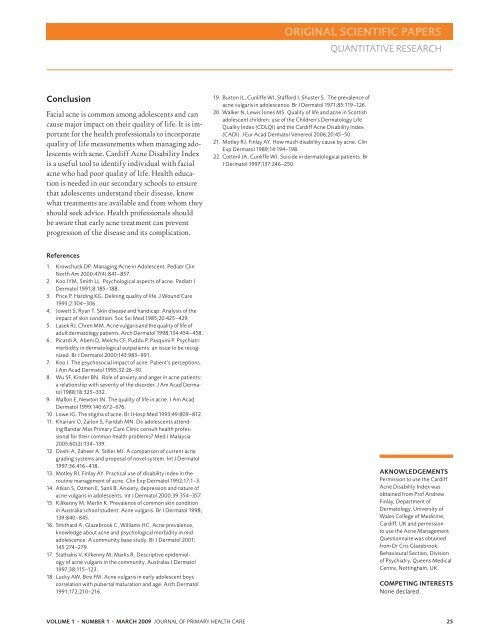entire issue. - The Royal New Zealand College of General ...
entire issue. - The Royal New Zealand College of General ...
entire issue. - The Royal New Zealand College of General ...
Create successful ePaper yourself
Turn your PDF publications into a flip-book with our unique Google optimized e-Paper software.
Conclusion<br />
Facial acne is common among adolescents and can<br />
cause major impact on their quality <strong>of</strong> life. It is important<br />
for the health pr<strong>of</strong>essionals to incorporate<br />
quality <strong>of</strong> life measurements when managing adolescents<br />
with acne. Cardiff Acne Disability Index<br />
is a useful tool to identify individual with facial<br />
acne who had poor quality <strong>of</strong> life. Health education<br />
is needed in our secondary schools to ensure<br />
that adolescents understand their disease, know<br />
what treatments are available and from whom they<br />
should seek advice. Health pr<strong>of</strong>essionals should<br />
be aware that early acne treatment can prevent<br />
progression <strong>of</strong> the disease and its complication.<br />
References<br />
1. Krowchuck DP. Managing Acne in Adolescent. Pediatr Clin<br />
North Am 2000;47(4):841–857.<br />
2. Koo JYM, Smith LL. Psychological aspects <strong>of</strong> acne. Pediatr J<br />
Dermatol 1991;8:185–188.<br />
3. Price P, Harding KG. Delining quality <strong>of</strong> life. J Wound Care<br />
1993;2:304–306.<br />
4. Jowett S, Ryan T. Skin disease and handicap: Analysis <strong>of</strong> the<br />
impact <strong>of</strong> skin condition. Soc Sci Med 1985;20:425–429.<br />
5. Lasek RJ, Chren MM. Acne vulgaris and the quality <strong>of</strong> life <strong>of</strong><br />
adult dermatology patients. Arch Dermatol 1998;134:454–458.<br />
6. Picardi A, Abeni D, Melchi CF, Puddu P, Pasquini P. Psychiatri<br />
morbidity in dermatological outpatients: an <strong>issue</strong> to be recognized.<br />
Br J Dermatol 2000;143:983–991.<br />
7. Koo J. <strong>The</strong> psychosocial impact <strong>of</strong> acne: Patient’s perceptions.<br />
J Am Acad Dermatol 1995;32:26–30.<br />
8. Wu SF, Kinder BN. Role <strong>of</strong> anxiety and anger in acne patients:<br />
a relationship with severity <strong>of</strong> the disorder. J Am Acad Dermatol<br />
1988;18:325–332.<br />
9. Mallon E, <strong>New</strong>ton JN. <strong>The</strong> quality <strong>of</strong> life in acne. J Am Acad<br />
Dermatol 1999;140:672–676.<br />
10. Lowe JG. <strong>The</strong> stigma <strong>of</strong> acne. Br J Hosp Med 1993;49:809–812.<br />
11. Khairani O, Zaiton S, Faridah MN. Do adolescents attending<br />
Bandar Mas Primary Care Clinic consult health pr<strong>of</strong>essional<br />
for their common health problems? Med J Malaysia<br />
2005;60(2):134–139.<br />
12. Doshi A, Zaheer A, Stiller MJ. A comparison <strong>of</strong> current acne<br />
grading systems and proposal <strong>of</strong> novel system. Int J Dermatol<br />
1997;36:416–418.<br />
13. Motley RJ, Finlay AY. Practical use <strong>of</strong> disability index in the<br />
routine management <strong>of</strong> acne. Clin Exp Dermatol 1992;17:1–3.<br />
14. Atkan S, Ozmen E, Sanli B. Anxiety, depression and nature <strong>of</strong><br />
acne vulgaris in adolescents. Int J Dermatol 2000;39:354–357.<br />
15. Killkenny M, Merlin K. Prevalence <strong>of</strong> common skin condition<br />
in Australia school student: Acne vulgaris. Br J Dermatol 1998;<br />
139:840–845.<br />
16. Smithard A, Glazebrook C, Williams HC. Acne prevalence,<br />
knowledge about acne and psychological morbidity in mid<br />
adolescence: A community base study. Br J Dermatol 2001;<br />
145:274–279.<br />
17. Stathakis V, Kilkenny M, Marks R. Descriptive epidemiology<br />
<strong>of</strong> acne vulgaris in the community. Australas J Dermatol<br />
1997;38:115–123.<br />
18. Lucky AW, Biro FM. Acne vulgaris in early adolescent boys<br />
correlation with pubertal maturation and age. Arch Dermatol<br />
1991;172:210–216.<br />
ORIGINAL SCIENTIFIC PAPERS<br />
19. Burton JL, Cunliffe WJ, Stafford I, Shuster S. <strong>The</strong> prevalence <strong>of</strong><br />
acne vulgaris in adolescence. Br J Dermatol 1971;85:119–126.<br />
20. Walker N, Lewis Jones MS. quality <strong>of</strong> life and acne in Scottish<br />
adolescent children: use <strong>of</strong> the Children’s Dermatology Life<br />
quality Index (CDLqI) and the Cardiff Acne Disability Index<br />
(CADI). J Eur Acad Dermatol Venereol 2006;20:45–50.<br />
21. Motley RJ, Finlay AY. How much disability cause by acne. Clin<br />
Exp Dermatol 1989;14:194–198.<br />
22. Cotteril JA, Cunliffe WJ. Suicide in dermatological patients. Br<br />
J Dermatol 1997;137:246–250.<br />
qUANTITATIVE RESEARCH<br />
AKNOWLEDGEMENTS<br />
Permission to use the Cardiff<br />
Acne Disability Index was<br />
obtained from Pr<strong>of</strong> Andrew<br />
Finlay, Department <strong>of</strong><br />
Dermatology, University <strong>of</strong><br />
Wales <strong>College</strong> <strong>of</strong> Medicine,<br />
Cardiff, UK and permission<br />
to use the Acne Management<br />
questionnaire was obtained<br />
from Dr Cris Glazebrook,<br />
Behavioural Section, Division<br />
<strong>of</strong> Psychiatry, queens Medical<br />
Centre, Nottingham, UK.<br />
COMPETING INTERESTS<br />
None declared.<br />
VOLUME 1 • NUMBER 1 • MARCH 2009 J OURNAL OF PRIMARY HEALTH CARE 25

















